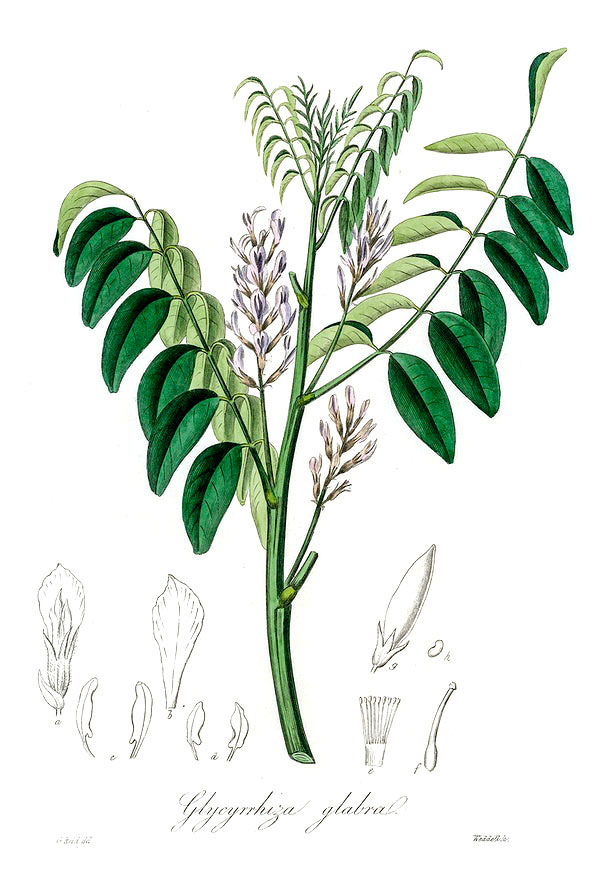Licorice

Origin: Western Asia and southern/eastern Europe
Family: Fabaceae
Subfamily: Faboideae
Scientific Name: Glycyrrhiza glabra
Folk Names: Lacris, liquorice, reglisse (Welsh), sweet root
Magical
Element: Earth
Day: Wednesday
Planet: Mercury
Zodiac: Virgo
Parts used: Root
Magical Properties: Love, lust, protection, passion, communication, fidelity.
Substitutions: Ginger
Lore
Pliny the Elder wrote in his Natural History that keeping a piece of licorice root in the mouth staved off hunger and thirst, as well as clearing the voice.
Dioscorides fed licorice root to the troops of Alexander the Great to give them stamina and endurance during long marches.
Magical Uses
- Chew on a piece of licorice root to incite passion.
- Consume licorice to encourage eloquence, humour, and influence in speech.
Medicinal
Note: This information is provided for informational purposes only, do not use any plants medicinally without consulting with an appropriate medical professional.
Medicinal Properties: Alterative, anti-inflammatory, antimicrobial, demulcent, emollient, expectorant, laxative, tonic
Active Constituents: Glycyrrhizin/glycyrrhetinic acid
Medicinal Uses:
Digestion: Licorice lowers stomach acid to help relieve indigestion and heartburn, and it helps to soothe food poisoning, nausea, and sea-sickness. It can assist with healing ulcers, and its anti-inflammatory properties can help to counter inflammatory bowel conditions. Licorice supports liver function, lowers cholesterol levels, and is also a mild laxative.
Immune System: As an antiviral, licorice has been attributed with combatting Herpes. Its anti-inflammatory properties can assist with arthritis, asthma and hay fever, and skin conditions such as eczema and psoriasis. Glycyrrhizin functions similarly to adrenal hormones like cortisol, but without the negative side effects.
Nervous System: Licorice is an adaptogenic tonic: it helps to improve tolerance to physical and mental stress, and can help with adrenal fatigue, nervous exhaustion, and fibromyalgia.
Reproductive System: Licorice can produce effects similar to estrogen, which can help with menstrual and menopausal problems: it can help curb heavy periods, including those caused by peri-menopause, and can also help those with PCOS. It’s been known to improve low sperm count, infertility, low libido, and other sexual dysfunction. Licorice has also been used to increase breast milk production.
Respiratory System: As an anti-allergenic, licorice can be used to soothe hay fever and asthma. Its soothing qualities can help reduce the irritation and inflammation associated with sore throats and harsh, dry coughs. Licorice’s expectorant qualities can also be utilised to treat asthma, coughs, and chest infections.
Interactions:
- Licorice can increase the breakdown of warfarin, decreasing its effectiveness.
- Licorice affects hormone levels, and might interfere with the effect of estrogen-based medications.
- Large amounts of licorice seem to increase blood pressure, which could interfere with blood pressure medications.
- Licorice might affect how the liver breaks down medications. Any medications processed by the liver could be impacted, either increasing or decreasing their effectiveness.
- Consuming licorice in large amounts can decrease potassium levels, which can increase the side effects of digoxin. Combined with corticosteroids, diuretics, ethacrynic acid, or furosemide, licorice could cause potassium levels to drop dangerously low.
Warnings:
- Licorice should be avoided by those with kidney problems, as it may exacerbate them.
- Consuming large amounts of licorice while pregnant may lead to miscarriage or early delivery.
- Licorice should be avoided by those who have hormone-sensitive conditions due to its impact on estrogen.
- The decrease in potassium levels that licorice can cause can be problematic for those with hypokalemia or hypertonia.
- Licorice can raise blood pressure, be cautious if you already have blood pressure issues, or have any upcoming/recent surgeries.
- Licorice can increase the risk of irregular heartbeat. It can also cause water retention, which can worsen congestive heart failure.
- Consuming large amounts of licorice regularly over the course of several weeks can lead to a number of side effects, including weakness, high blood pressure, low potassium, irregular heart rhythms, heart attack, and paralysis. These effects have been recorded in those who regularly drink licorice tea, consume large amounts of liquorice confectionery (or lozenges high in licorice), or chew tobacco flavoured with licorice.
Practical
The most common use of licorice is in food products, although it is also used to flavour various tobacco products.
Culinary
Most popularly, licorice is used to make a variety of sweets. Most liquorice confections are primarily flavoured with aniseed, although do usually contain varying amounts of licorice.
Beauty
Licorice is often used as a mouth freshener (in its natural form, or unsweetened pastilles or liqueurs), particularly in France, Spain, and southern Italy.
Botanical
Licorice is one of 20 species in the genus Glycyrrhiza, species of which are found on every continent.
Type: Herb
Plant Height: 1m
Leaves: 7-15cm long, made of 9-17 oblong leaflets
Flowers: Purple to pale flowers roughly 1cm long, in a loose inflorescence
Fruit: Oblong pods, 2-3cm long containing multiple seeds
Etymology: ‘Licorice’ comes from the Greek glukurriza, meaning “sweet root”.
In the Garden
Type: Perennial
Sow: Spring/early summer
Light: Full sun to partial shade
Water: Moderate
Soil: Light, loamy, and well-drained
Companion Planting: Licorice grows well with calendula,
marjoram,
rosemary,
lettuce, and zinnia.
Do not plant with garlic, onions, leek, broccoli, cabbage, or cauliflower.
Tips:
- Licorice prefers slightly acidic soil.
- Roots can be harvested in autumn about 3 years after planting.
- Once a licorice plant is established it can quickly take over an area. As such, it is best planted in raised beds where it can’t spread.
